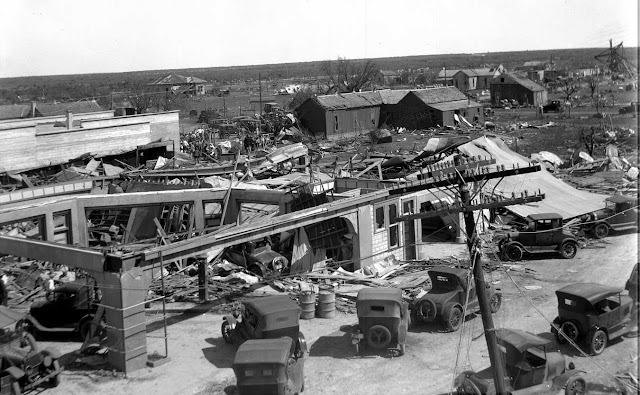 |
| Rocksprings, Texas, after the F5 Tornado crashed through town on April 12, 1927 |
Of the community's roughly 247 buildings, only a dozen remained standing after the storm hit.
Rocksprings, for those who might not know, is the county seat of Edwards County, which borders Kerr County to the west; it's about 77 miles by car from Kerrville to Rocksprings.
I'm thankful to my business neighbor and fellow history enthusiast Dayton Baublit for reminding me of the anniversary of the Rocksprings disaster, and for loaning me photographs of its aftermath.
April 12, 1927 started out as a normal Texas hill country day, though a storm was building on the horizon. That evening, at dusk, as families gathered around their dinner tables, the skies turned dark and the electricity went out. Several of the surviving families mentioned the lights going out as the storm hit. In five minutes the tornado had leveled most of Rocksprings.
The tornado touched down northwest of Rocksprings and traveled toward the southeast. When it crossed Rocksprings, it was nearly one mile wide, according to the National Weather Service website. It tore through the town, and continued on for at least 35 miles, and perhaps as far as 65.
Getting help to Rocksprings was difficult because the roads were not like our modern highways. Traveling to Rocksprings in those days was a difficult journey over rough roads, in vehicles not noted for their smooth rides.
 |
| Another view of the destruction |
With so many of the buildings destroyed, it was imperative to get the injured to hospitals, many of them to hospitals in San Antonio.
Most of the injured were carried to nearby Camp Wood, about 30 miles south, because it had the nearest railroad, the Uvalde and Northern Railroad, and sent by train first to Uvalde, and then to hospitals in San Antonio. Others were flown to San Antonio via the Kelly Field aerial ambulance service, which provided 10 relief planes. Other planes from Fort Sam Houston and Brooks Field were involved in relief work, as well.
The dead were buried in the local cemetery, their graves blasted out of the stony site with dynamite. Families were buried together, but family lots could not be designated. There was no local undertaker, and coffins had to be brought in from other communities.
Sixteen bodies buried in the cemetery were never identified, and rest under a marker which reads "Unknown/16 Graves."
The San Antonio Express of April 14, 1927, tells of the survivors:
"Not only do they have no homes to go to, but survivors of the cyclone are without [a change of] clothes. Nearly every man and woman has blood on his or her clothes.
"Having partially completed their humanitarian work, after 24 hours ministering to the dead and dying, the residents too tired to further carry on stood in the streets and cried Wednesday night as darkness settled over the stricken town."
The story of the Rocksprings tornado is a story of tragedy, but also a story of bravery and hope. Countless acts of bravery and charity were freely given in the days following the disaster. Rocksprings rebuilt after the tornado, and while that day cannot be forgotten, the history of the community since then has been one of families helping families, of economic growth, and of service to others.
Until next week, all the best.
Joe Herring Jr. is a Kerrville native who enjoys visiting with his friends from Rocksprings. This column originally appeared in the Kerrville Daily Times April 21, 2018.


No comments:
Post a Comment
Please remember this is a rated "family" blog. Anything worse than a "PG" rated comment will not be posted. Grandmas and their grandkids read this, so please, be considerate.